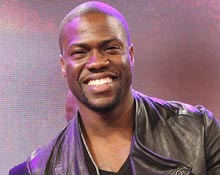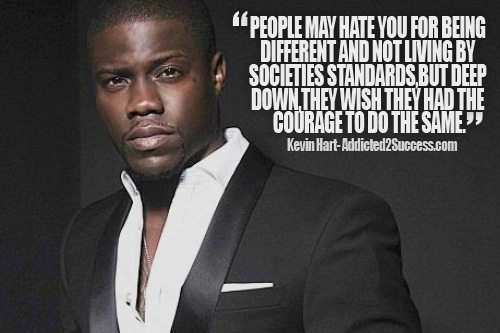Success Advice
7 Reasons Why Kevin Hart Is So Successful

It’s no doubt that Kevin Hart is one of the hottest properties in the comedy business right now. At 33, he’s enjoying the peak of his career and even has more Twitter followers than Seinfeld and Chris Rock put together. Kevin Hart also recently released a very successful documentary covering his 2012 Tour “Let Me Explain” and has a hit TV series.
So what paved the road for Kevin’s current success?
Here is, what we believe to be, the “7 Reasons Why Kevin Hart Is So Successful“.
Kevin Hart’s Success
He Quit His Job!
 At 18 years of age, Hart was developing a very successful career as a shoe salesman. He was even offered a career-changing opportunity with Nike. He turned the offer down. Instead, it was a signal for him to turn to his true passion of comedy.
At 18 years of age, Hart was developing a very successful career as a shoe salesman. He was even offered a career-changing opportunity with Nike. He turned the offer down. Instead, it was a signal for him to turn to his true passion of comedy.
Kevin Hart had the guts to take a massive risk and it paid off, even if it took him a little longer to make his goals happen.
Making the most of Social Media
 Hart’s success really makes a case for using social media in marketing campaigns. He actively engages with his fans, often sharing content and exchanging messages with fans on platforms such as Youtube and Twitter. He doesn’t let an assistant manage his social accounts either, being personally involved in everything he does online.
Hart’s success really makes a case for using social media in marketing campaigns. He actively engages with his fans, often sharing content and exchanging messages with fans on platforms such as Youtube and Twitter. He doesn’t let an assistant manage his social accounts either, being personally involved in everything he does online.
Kevin wants to make fans feel a part of what he’s doing. “I chose to make them part of my journey,” he once explained.
His fame doesn’t get to his head
 While Kevin Hart is now one of the biggest names in comedy, he still makes self-deprecating jokes and doesn’t take himself too seriously. For example, Kevin often pokes fun at his height (he’s 5’2), his poor background and his dismal failures with attractive women.
While Kevin Hart is now one of the biggest names in comedy, he still makes self-deprecating jokes and doesn’t take himself too seriously. For example, Kevin often pokes fun at his height (he’s 5’2), his poor background and his dismal failures with attractive women.
In addition to Hart’s social media efforts, this style of humour makes him a very relatable comedian. His act makes him come off as a regular guy rather than the superstar he’s now become. People are not receptive of egotistical entertainers and Kevin Hart understands this very well.
He never gave up on his dream
 Hart has been involved in this business for over 15 years, but he’s only recently been reaping the benefits. He’s been part of plenty of failures and disappointments, such as box office flops Soul Plane and Fool’s Gold. For several years he couldn’t get an audition, let alone a role in a movie or TV show. No one would have blamed him had he turned to another career.
Hart has been involved in this business for over 15 years, but he’s only recently been reaping the benefits. He’s been part of plenty of failures and disappointments, such as box office flops Soul Plane and Fool’s Gold. For several years he couldn’t get an audition, let alone a role in a movie or TV show. No one would have blamed him had he turned to another career.
Kevin Hart never gave up on his dream, however, and built himself up from the very bottom through hard work. Examples of his perseverance include doing up to seven shows per weekend at venues such as college campuses and low-key comedy clubs. While he calls it a “rough stint” in his career, it nevertheless showed him that the way to success is never easy. His work ethic is now one of his major strengths and keeps him at the top of his game, even after all of the fame and fortune.
Personal Development and Innovation
 Even when he reached the top of his game, Hart never stopped focusing on his development as an artist. This has been a thread throughout his career, despite early failures. When he first began as a stand-up comic, he would often stick to standard jokes that didn’t bring anything new to the table.
Even when he reached the top of his game, Hart never stopped focusing on his development as an artist. This has been a thread throughout his career, despite early failures. When he first began as a stand-up comic, he would often stick to standard jokes that didn’t bring anything new to the table.
Kevin explained that most of his gags were based on “white people do this and black people do that.” More than a decade later, his act is now one of the most innovative and creative in the comedy world.
Taking the advice from other successful people
 It’s always a good idea to listen to those that have walked the walk. Chris Rock once gave Kevin Hart the solid piece of advice of always sticking to his guns and backing up his own brand no matter what. As a result, he never joined group tours, instead focusing on developing his own stand-up act.
It’s always a good idea to listen to those that have walked the walk. Chris Rock once gave Kevin Hart the solid piece of advice of always sticking to his guns and backing up his own brand no matter what. As a result, he never joined group tours, instead focusing on developing his own stand-up act.
While it made the road to success a little longer and more difficult, it was certainly worth listening to Mr Rock!
Using Life Experiences in his Stand-Up
 Kevin Hart has had some tough times in the past, including going through a painful divorce and a father battling drug addiction. His career wasn’t always full of praise and admiration either. He was booed off the stage plenty of times and he was once thrown a half-eaten chicken wing by a heckler! He never let these negative experiences discourage him, however, but instead included them in his act, which is a very smart move on Kevin’s part.
Kevin Hart has had some tough times in the past, including going through a painful divorce and a father battling drug addiction. His career wasn’t always full of praise and admiration either. He was booed off the stage plenty of times and he was once thrown a half-eaten chicken wing by a heckler! He never let these negative experiences discourage him, however, but instead included them in his act, which is a very smart move on Kevin’s part.
Some of Kevin Hart’s funniest pieces mock some of the experiences he’s gone through, making a great way of turning a negative into a positive! Kevin inspires others to be real with themselves and their experiences.
Kevin Hart Picture Quote

Did You Know
How Skilled Migrants Are Building Successful Careers After Moving Countries
Behind every successful skilled migrant career is a mix of resilience, strategy, and navigating systems built for locals.

Moving to a new country for work is exciting, but it can also be unnerving. Skilled migrants leave behind familiar systems, networks, and support to pursue better job opportunities and a better future for their families. (more…)
Life
10 Research-Backed Steps to Create Real Change This New Year
This New Year could finally be the one where you break old patterns and create real, lasting change.

Every New Year, we make plans and set goals, but often repeat old patterns. (more…)
Change Your Mindset
The Silent Skill That Makes People Respect You Instantly
What truly earns respect and why most people go about it the wrong way

Everybody craves respect but not everyone earns it. Some people believe that a title, years of experience, or a position of authority automatically entitles them to respect. (more…)
Entrepreneurs
The Essential Skills Every Entrepreneur Needs In 2026
Success in the digital age isn’t about luck. It’s about mastering the skills that separate dreamers from doers.

When I was 22 years old, I started my first side hustle as a ghostwriter. (more…)
-

 Did You Know4 weeks ago
Did You Know4 weeks agoThe Success Patterns You Inherited (And Didn’t Notice)
-

 Entrepreneurs4 weeks ago
Entrepreneurs4 weeks agoThe Essential Skills Every Entrepreneur Needs In 2026
-

 Change Your Mindset3 weeks ago
Change Your Mindset3 weeks agoHow to Turn Your Mind Into Your Greatest Asset (Instead of Your Enemy)
-

 Change Your Mindset3 weeks ago
Change Your Mindset3 weeks agoThe Silent Skill That Makes People Respect You Instantly
-

 Life2 weeks ago
Life2 weeks ago10 Research-Backed Steps to Create Real Change This New Year
-

 Tech2 weeks ago
Tech2 weeks agoWhat’s in a Name? How to Get Your Domain Right
-

 Did You Know1 week ago
Did You Know1 week agoHow Skilled Migrants Are Building Successful Careers After Moving Countries

























8 Comments